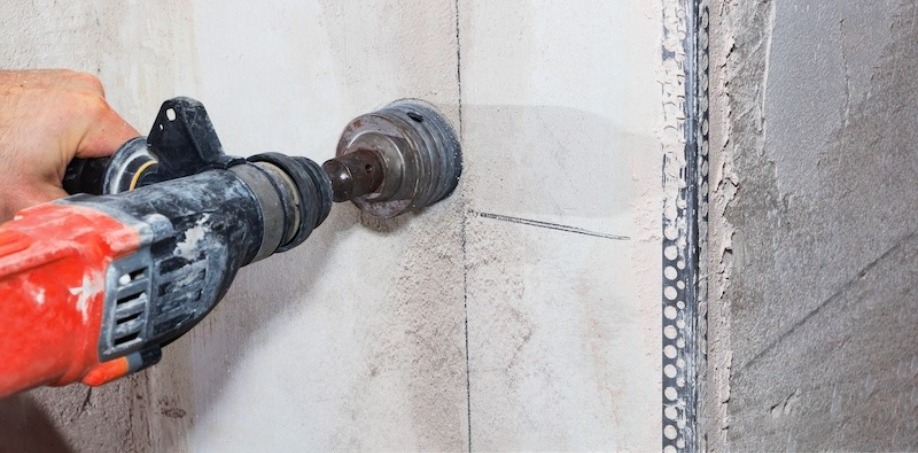Core Drills: A Complete Guide

When tackling construction projects, having the right tools can make all the difference. One such tool, the core drill, is a powerful and precise instrument used for cutting large holes in masonry, concrete, and other dense materials. Whether you’re running cables, installing pipes, or adding an extractor fan, understanding how to use a core drill effectively is key to achieving professional results. In this guide, we’ll explore what a core drill is, its various applications, how it works, and step-by-step instructions for using it safely and efficiently.
What Is a Core Drill?
A core drill is a specialized drill bit designed to cut large, cylindrical holes through tough materials like brick, block, and concrete. Unlike standard drill bits, which grind away all the material in the hole, a core drill removes only the circumference of the hole, leaving behind a solid "core" in the center. This unique design not only increases drilling efficiency but also minimizes material waste.
Core drills come in a variety of sizes, typically corresponding to the diameter of pipes, cables, or ducts that will pass through the hole. They are often used with power drills that have high torque and variable speed capabilities to ensure smooth operation and precise results.

What Is a Core Drill Used For?
Core drills can be used for a wide range of tasks in construction, renovation, and DIY projects. Here are some of the most common applications:
Running Cables: Electricians often use core drills to create clean, precise holes for routing electrical cables through walls.
Installing Plumbing: Plumbers rely on core drills to make openings for waste pipes, soil pipes, and water supply lines.
Adding Ventilation: Core drills are ideal for cutting holes to install extractor fans and ductwork in kitchens, bathrooms, and HVAC systems.
Structural Work: In construction, core drills are used for creating openings in concrete or masonry for anchor bolts, structural reinforcements, or other architectural features.
How Does a Core Drill Work?
Core drills operate by cutting a circular groove into the material, gradually removing a cylindrical "core" as the bit progresses. The efficiency and effectiveness of this process depend on several factors:
Drill Power: Core drills require a powerful drill with a wattage of 800 to 1300 watts, variable speed control (100 to 300 RPM), and a safety clutch to prevent injury in case of binding.
Cooling Mechanisms: Diamond core bits often use water (wet cutting) to cool the teeth during drilling, which prevents overheating and extends the bit’s lifespan. Dry cutting bits, on the other hand, rely on intermittent operation and air cooling.
Arbor and Guide Bit: Most core bits attach to the drill using an arbor, a specialized adapter. A guide or pilot drill within the arbor helps stabilize the bit and ensure accuracy during the initial stages of drilling.

How to Use a Core Drill
Using a core drill requires preparation, the right equipment, and attention to safety. Follow these steps to ensure a successful and safe drilling experience:
1. Gather Your Tools and Safety Gear
Before starting, ensure you have all necessary tools, including the core drill bit, power drill, and an arbor with a guide bit. Additionally, wear appropriate safety equipment, such as gloves, safety goggles, a dust mask, and ear protection.2. Mark the Drilling Spot
Carefully measure and mark the exact location where you need to drill. Accuracy is crucial, as correcting mistakes with large holes is challenging. If possible, use a pipe and cable detector to ensure the area is free of hidden utilities.3. Assemble the Core Drill
Attach the core bit to the arbor and insert the guide bit into the arbor’s center. Securely connect the assembly to your power drill, ensuring it is tightly fastened. For drills with SDS chucks, align the shank and lock it into place.4. Start Drilling
Place the guide bit on your marked spot and begin drilling at a low speed. Once the guide bit penetrates the surface, increase the speed slightly and allow the core bit’s teeth to engage. Avoid using hammer mode, as this can damage the bit and create uneven holes.5. Maintain Alignment
Hold the drill level and steady to ensure the hole is straight. Regularly pause and withdraw the core bit to clear debris and allow cooling. This is especially important when using dry cutting diamond bits to prevent overheating.6. Manage Depth
For deep walls, drill in stages. Stop when the bit reaches its maximum depth, remove the core, and resume drilling. If possible, switch to the opposite side of the wall to complete the hole, ensuring a clean exit.7. Finish the Hole
Reduce speed and pressure as you approach the end of the hole to prevent damaging the wall’s exterior. Once the hole is complete, remove any remaining debris and inspect the cut for accuracy.
Core drills are a versatile and powerful tool for creating precise holes in masonry and concrete. By understanding their design, applications, and operation, you can tackle a variety of projects with confidence and efficiency. Whether you’re running cables, installing pipes, or adding ventilation, following proper techniques and safety guidelines will ensure professional results every time. If you are in need of a core drill, give our sales team a call, at 877-446-4352.

